Kristine Hughes's Blog, page 92
May 23, 2014
THE DUKE OF WELLINGTON TOUR - VIDEO HIGHLIGHTS - PART 11
BASILDON PARK
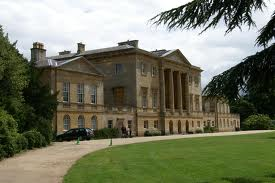
After leaving Stratfield Saye, our group will travel to nearby Basildon Park for a private tour of this stately home.
From their website:
Basildon Park, a Georgian mansion surrounded by parkland, was loving rescued by Lord and Lady Iliffe in the mid 1950s. The house you see today is a re-creation and restoration of the 18th-century mansion. They restored the elegant interior and scoured the country salvaging 18th-century architectural fixtures and fittings. Lord and Lady Iliffe filled their comfortable new home with fine paintings, fabrics and furniture, which can still be enjoyed by you today. Make the most of your visit by treating yourself to a cream tea, experience the nostalgia of our 1950s kitchen, or stretch your legs following one of our waymarked trails through the 400 acres of historic parkland.
Basildon Park was originally built for Sir Francis Sykes and you can read the entire history of Sykes, his waning fortunes and the history of the house here. The Regency history of Basildon Park is interesting and I quote from Wikipedia as follows:
"On Sir Francis Sykes' death, Basildon was inherited by his son, Sir Francis Sykes (2nd Baronet) who died a few weeks later. The house then passed to his grandson, the five-year old Sir Francis (3rd Baronet). By this time, the Sykes fortune was almost spent and Basildon was already mortgaged. The family finances suffered further as a result of the 3rd Baronet's association with the extravagant Prince Regent. Aged just 14, he entertained the Prince at Basildon. As a result of the Prince's occupation of the North side of the second floor, where the best bedrooms are located, for many years afterwards this range of rooms were known as `The Regent's Side' as opposed to the family's less formal rooms on the South side of the floor. From the late 1820s, Sykes was suffering serious financial problems, and in 1829, the estate was placed on the market. The house was not quickly sold, as Sykes refused to accept any price less than £100,000. During this period, the house was often let. However, Sykes and his family were in residence between 1834 and 1835 when the future Prime Minister Benjamin Disraeli was a house-guest at Basildon. Disraeli, who was the lover of Sykes' wife Henrietta, immortalised her along with some descriptions of Basildon and its rooms in his novel, Henrietta Temple: A Love Story . Another romantic attachment of Lady Sykes was to result in her husband being immortalised in a novel, this time in a less flattering light. Lady Sykes had been conducting an affair with the painter Daniel Maclise. Her husband publicly denounced Maclise, causing an unacceptable high society scandal. As a result, Charles Dickens, a friend of Maclise, then writing Oliver Twist , based his villainous and cruel character Bill Sikes on Sir Francis."
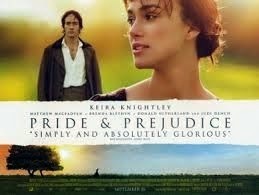
Basildon Park's literary connections did not end with Disraeli and Dickens - the house was used as the setting for Netherfield Park during the filming of the 2005 version of Jane Austen's Pride and Prejudice. You can watch a short video about the filming at Basildon Park here. The house was used as a set for another Keira Knightley film, The Duchess, in 2008.

The interiors of Basildon Park were most recently used as the Crawley family’s London residence, Grantham House, and the elegant Georgian mansion was at the heart of the unfolding story as the family prepared for Rose’s coming out ball in the capital. Basildon Park played host to all of the much loved regular characters from the show as well as Shirley MacLaine who reprises her role as Martha Levinson and Paul Giamatti who joins the cast as Cora’s playboy brother, Harold. The episode was part of Downton Abbey's 2013 Christmas special. You can watch a video of which rooms were used in the filming and short clips from the Special here.
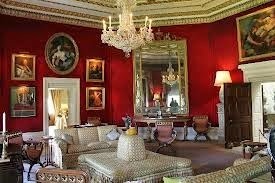
You can take a half hour video tour of Basildon Park, it's interiors and learn about it's history and occupants here.
FIND COMPLETE ITINERARY FOR THE DUKE OF WELLINGTON TOUR HERE

After leaving Stratfield Saye, our group will travel to nearby Basildon Park for a private tour of this stately home.
From their website:
Basildon Park, a Georgian mansion surrounded by parkland, was loving rescued by Lord and Lady Iliffe in the mid 1950s. The house you see today is a re-creation and restoration of the 18th-century mansion. They restored the elegant interior and scoured the country salvaging 18th-century architectural fixtures and fittings. Lord and Lady Iliffe filled their comfortable new home with fine paintings, fabrics and furniture, which can still be enjoyed by you today. Make the most of your visit by treating yourself to a cream tea, experience the nostalgia of our 1950s kitchen, or stretch your legs following one of our waymarked trails through the 400 acres of historic parkland.
Basildon Park was originally built for Sir Francis Sykes and you can read the entire history of Sykes, his waning fortunes and the history of the house here. The Regency history of Basildon Park is interesting and I quote from Wikipedia as follows:
"On Sir Francis Sykes' death, Basildon was inherited by his son, Sir Francis Sykes (2nd Baronet) who died a few weeks later. The house then passed to his grandson, the five-year old Sir Francis (3rd Baronet). By this time, the Sykes fortune was almost spent and Basildon was already mortgaged. The family finances suffered further as a result of the 3rd Baronet's association with the extravagant Prince Regent. Aged just 14, he entertained the Prince at Basildon. As a result of the Prince's occupation of the North side of the second floor, where the best bedrooms are located, for many years afterwards this range of rooms were known as `The Regent's Side' as opposed to the family's less formal rooms on the South side of the floor. From the late 1820s, Sykes was suffering serious financial problems, and in 1829, the estate was placed on the market. The house was not quickly sold, as Sykes refused to accept any price less than £100,000. During this period, the house was often let. However, Sykes and his family were in residence between 1834 and 1835 when the future Prime Minister Benjamin Disraeli was a house-guest at Basildon. Disraeli, who was the lover of Sykes' wife Henrietta, immortalised her along with some descriptions of Basildon and its rooms in his novel, Henrietta Temple: A Love Story . Another romantic attachment of Lady Sykes was to result in her husband being immortalised in a novel, this time in a less flattering light. Lady Sykes had been conducting an affair with the painter Daniel Maclise. Her husband publicly denounced Maclise, causing an unacceptable high society scandal. As a result, Charles Dickens, a friend of Maclise, then writing Oliver Twist , based his villainous and cruel character Bill Sikes on Sir Francis."

Basildon Park's literary connections did not end with Disraeli and Dickens - the house was used as the setting for Netherfield Park during the filming of the 2005 version of Jane Austen's Pride and Prejudice. You can watch a short video about the filming at Basildon Park here. The house was used as a set for another Keira Knightley film, The Duchess, in 2008.

The interiors of Basildon Park were most recently used as the Crawley family’s London residence, Grantham House, and the elegant Georgian mansion was at the heart of the unfolding story as the family prepared for Rose’s coming out ball in the capital. Basildon Park played host to all of the much loved regular characters from the show as well as Shirley MacLaine who reprises her role as Martha Levinson and Paul Giamatti who joins the cast as Cora’s playboy brother, Harold. The episode was part of Downton Abbey's 2013 Christmas special. You can watch a video of which rooms were used in the filming and short clips from the Special here.

You can take a half hour video tour of Basildon Park, it's interiors and learn about it's history and occupants here.
FIND COMPLETE ITINERARY FOR THE DUKE OF WELLINGTON TOUR HERE
Published on May 23, 2014 00:00
May 21, 2014
LOVE, LIFE, AND LAUGHTER: A TREASURE RETURNS
 Image Credit: British Film Institute via Silent London
Image Credit: British Film Institute via Silent LondonBy Guest Blogger Spencer Blohm
One of the many things that most of us don’t give up on from our childhood is that tiny sliver of hope that we’ll somehow find hidden treasure. It may not be as extravagant as finding a secret passageway in your living room to a tunnel of gold, but most of us can’t deny that little rush when they think they may have found something of value (after all, Antiques Roadshow has made an entire series about it).
The Dutch film institute, known as EYE, had that feeling when they started unpacking the shipment of films earlier this year that they had originally received in November of 2012. The package consisted of leftover film cans from an older building in a rural Dutch town that had briefly been used as a cinema in the late 20’s. In the package, they discovered one of the BFI’s most sought after films: Love, Life, and Laughter. The 1923 silent film, directed by George Pearson, is a landmark find for the BFI, who had assumed that this film, like so many other silents, was destroyed or recycled following the bank crisis of 1924 (which put many studios out of business).
The film stars the enigmatic Betty Balfour, the most famous British actress of the silent film era, and is generally regarded as the British equivalent to the United States’ Mary Pickford. Love, Life and Laughter is the film which launched Balfour’s career and was just one of a series of critically and commercially successful collaborations between Balfour and Pearson. It’s a particularly significant find for Pearson fans too, since it is only the second film of his that the BFI possesses a complete version of.
In the film, Balfour plays Tip Toes, a down on her luck chorus girl who yearns to be center stage. She befriends a young writer in a similar situation to her own (played by Harry Jonas), and the two agree to meet up two years later in order to see if either of them made it big. The film, naturally, wouldn’t have been such a hot commodity if it wasn’t regarded as a cinematic masterpiece, with Balfour receiving much praise. Adding to its allure is the fact that it is somewhat of an anomaly being a full length film, since it was produced during a short period where studios decided to expand the length of their silent films.
The BFI is hoping to receive a copy from EYE, so that they can translate the Dutch intertitles and screen it for audiences within the next year. This discovery is the ultimate lost treasure for film buffs all around the world, not just in Britain, and shows that perhaps we shouldn’t give up on those childhood wishes after all.
About the Author: Spencer Blohm is a freelance entertainment, film, and pop culture blogger for DirectTelevisionSpecials.org. Despite multiple attempts, he’s never been able to find hidden treasures or films in either of his grandparent’s attics. He lives and works in Chicago, where he can often be found scouring flea markets looking for a big find.
Published on May 21, 2014 00:00
May 19, 2014
ANOTHER LOOK AT THE NGA's EARLY AMERICAN FURNITURE COLLECTION
Victoria here. In 2013, I was delighted to have the opportunity to explore the newly installed collection of early American furniture in D.C.'s National Gallery of Art (the post is here). A few weeks ago, I went back for another visit. Historical fiction writer Diane Gaston and I love browsing through the galleries -- almost as much as we enjoy our luncheon in the charming Garden Café. In the distant background is the Gallery of the Kaufman Collection, which had to wait until we were well nourished.
 Vicky and Diane
Vicky and Diane
 Desk and Bookcase, Pair of SidechairsPhiladelphia, 1755-1771, Mahogany Glass, Brass
Desk and Bookcase, Pair of SidechairsPhiladelphia, 1755-1771, Mahogany Glass, Brass
Philadelphia was the leading city of pre-revolutionary America. Colonial furniture makers followed the pattern books of leading English designers such as Thomas Chippendale. Many immigrant craftsmen came to the colonies, and fine imported goods arrived to serve the tastes and growing wealth of leading families. At the top of the desk is a mahogany bust "believed" to be of Catherine Macaulay (1731-1791), a renowned historian and author who "was a great supporter of American liberty." (from the gallery label)
 High Chest, Philadelphia 1750-65Mahogany and sabicu (a hardwood imported from the West Indies); brass
High Chest, Philadelphia 1750-65Mahogany and sabicu (a hardwood imported from the West Indies); brass
Makers of furniture in various cities of colonial America had their own versions of the English models, with a variety of distinctive characteristics and decoration that enables experts to immediately identify the city of origin of many pieces.
 Chest-in-Chest, Providence, 1775-85Mahogany and Brass
Chest-in-Chest, Providence, 1775-85Mahogany and Brass
The Providence style is similar to the characteristics of the Newport style. Here is the major difference: the "convex shells on the top drawer of the lower case are carved from the solid drawer front, rather than separately carved and applied. The original owner of this chest was the Providence merchant John Brown (1736-1893) who founded Brown University with his three brothers."
 Ann Barry, 1803-05 by Gilbert Stuart (American, 1755-1828)Oil on Canvas
Ann Barry, 1803-05 by Gilbert Stuart (American, 1755-1828)Oil on Canvas
Pair of Covered Vases, Jingdozhen, China 1790-1810'=Hard-paste porcelain
Card Table, signed ad dated by Robert McGuffin (1779/80-after 1863)Philadelphia 1807Satinwood and veneers
After the Revolutionary War, styles gradually evolved into what Americans call the Federal Style, based on the increased use of ancient Greek and Roman designs by Europeans. The somewhat simpler lines of the furniture are more neo-classical than rococo.
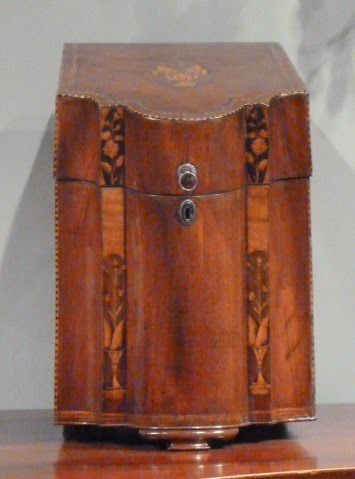 Knife Box, one of a pairAmerican 1785-1815mahogany and veneers with wood inlay; silver
Knife Box, one of a pairAmerican 1785-1815mahogany and veneers with wood inlay; silver
The photo above is included for the special enjoyment of Kristine Hughes. Victoria and Diane are well acquainted with Kristine's admiration for the myriad knife boxes she finds on her travels.
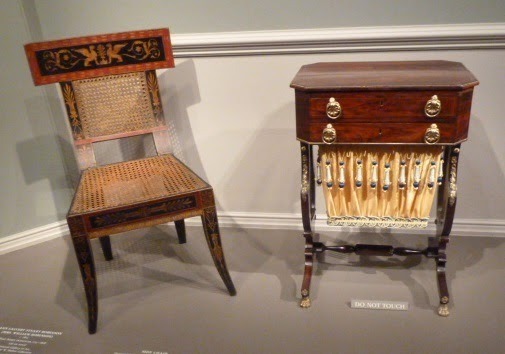 Side Chair, designed by Benjamin Henry Latrobe (1764-1820)decorated by George Bridport (1783-1819)Philadelphia 1808Poplar and Maple, gesso, paint, and gold leaf; cane seat
Side Chair, designed by Benjamin Henry Latrobe (1764-1820)decorated by George Bridport (1783-1819)Philadelphia 1808Poplar and Maple, gesso, paint, and gold leaf; cane seat
Worktable, Boston 1815-1825\Rosewood and veneers; bras; ormoluUsed for sewing and needlework
 National Gallery of Art West Building
National Gallery of Art West Building
Until next year!!
 Vicky and Diane
Vicky and Diane Desk and Bookcase, Pair of SidechairsPhiladelphia, 1755-1771, Mahogany Glass, Brass
Desk and Bookcase, Pair of SidechairsPhiladelphia, 1755-1771, Mahogany Glass, BrassPhiladelphia was the leading city of pre-revolutionary America. Colonial furniture makers followed the pattern books of leading English designers such as Thomas Chippendale. Many immigrant craftsmen came to the colonies, and fine imported goods arrived to serve the tastes and growing wealth of leading families. At the top of the desk is a mahogany bust "believed" to be of Catherine Macaulay (1731-1791), a renowned historian and author who "was a great supporter of American liberty." (from the gallery label)
 High Chest, Philadelphia 1750-65Mahogany and sabicu (a hardwood imported from the West Indies); brass
High Chest, Philadelphia 1750-65Mahogany and sabicu (a hardwood imported from the West Indies); brass Makers of furniture in various cities of colonial America had their own versions of the English models, with a variety of distinctive characteristics and decoration that enables experts to immediately identify the city of origin of many pieces.
 Chest-in-Chest, Providence, 1775-85Mahogany and Brass
Chest-in-Chest, Providence, 1775-85Mahogany and BrassThe Providence style is similar to the characteristics of the Newport style. Here is the major difference: the "convex shells on the top drawer of the lower case are carved from the solid drawer front, rather than separately carved and applied. The original owner of this chest was the Providence merchant John Brown (1736-1893) who founded Brown University with his three brothers."
 Ann Barry, 1803-05 by Gilbert Stuart (American, 1755-1828)Oil on Canvas
Ann Barry, 1803-05 by Gilbert Stuart (American, 1755-1828)Oil on CanvasPair of Covered Vases, Jingdozhen, China 1790-1810'=Hard-paste porcelain
Card Table, signed ad dated by Robert McGuffin (1779/80-after 1863)Philadelphia 1807Satinwood and veneers
After the Revolutionary War, styles gradually evolved into what Americans call the Federal Style, based on the increased use of ancient Greek and Roman designs by Europeans. The somewhat simpler lines of the furniture are more neo-classical than rococo.
 Knife Box, one of a pairAmerican 1785-1815mahogany and veneers with wood inlay; silver
Knife Box, one of a pairAmerican 1785-1815mahogany and veneers with wood inlay; silverThe photo above is included for the special enjoyment of Kristine Hughes. Victoria and Diane are well acquainted with Kristine's admiration for the myriad knife boxes she finds on her travels.
 Side Chair, designed by Benjamin Henry Latrobe (1764-1820)decorated by George Bridport (1783-1819)Philadelphia 1808Poplar and Maple, gesso, paint, and gold leaf; cane seat
Side Chair, designed by Benjamin Henry Latrobe (1764-1820)decorated by George Bridport (1783-1819)Philadelphia 1808Poplar and Maple, gesso, paint, and gold leaf; cane seatWorktable, Boston 1815-1825\Rosewood and veneers; bras; ormoluUsed for sewing and needlework
 National Gallery of Art West Building
National Gallery of Art West BuildingUntil next year!!
Published on May 19, 2014 00:30
May 16, 2014
THE DUKE OF WELLINGTON TOUR -- VIDEO HIGHTLIGHTS - PART 10
DOWNTON ABBEY
When we visit Highclere Castle on Thursday, September 11, 2014, we will probably be thinking more of Downton Abbey, the PBS Masterpiece series, than of the sumptuous home of the Earls of Carnarvon. Victoria here, as eager to see the Castle/Abbey as anyone. I truly believe that a large part of the credit for DA's success in America is due to the setting at Highclere Castle: The grounds, the enormous house designed in the most extravagant of Victorian neo-Gothic style, the magnificent interiors of the family's drawing rooms and bedchambers, the stark simplicity and dullness of the servants' world below stairs. The contrasts could not be more vivid.
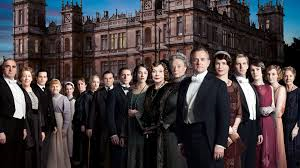 Downton Abbey, PBS Masterpiece
Downton Abbey, PBS MasterpieceThe Crawley family, headed by Robert, Earl of Grantham (High Bonneville), live at the fictional Downton Abbey, filmed at Highclere Castle, the home of the Earls of Carnarvon. Most of the upstairs scenes are filmed in the rooms of the Abbey or on the grounds. The servants quarters have been recreated as they would have been in 1900 to 1930 at studies on nearby Ealing, West London. In this 4-minute video, creator and writer Julian Fellowes takes you through Highclere. Click here.
Another look at Highclere as Downton Abbey is an 8-minute fragment of the program Countrywise visit. Click here
As almost every one knows, Downton Abbey has been a phenomenal success with audiences in Britain and North America, and elsewhere. The four years of the series have won numerous awards for its creator, Julian Fellowes, for its costumes and settings, and for the actors, some of whom have become "household names." Probably taking first place would be Violet, Dowager Countess of Grantham, whose pithy comments delight audiences on both sides of the Atlantic. Click here to see some favorite moments.
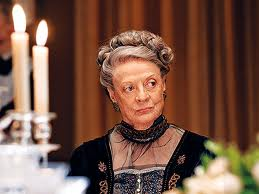 The Inimitable Maggie Smith As Violet, Dowager Lady Grantham We've seen four seasons of Downton Abbey now, and all the episodes are available on DVD and from PBS and other sources. The fifth season is in production and will be seen in the U.K. in the autumn and on PBS Masterpiece in early 2015.
The Inimitable Maggie Smith As Violet, Dowager Lady Grantham We've seen four seasons of Downton Abbey now, and all the episodes are available on DVD and from PBS and other sources. The fifth season is in production and will be seen in the U.K. in the autumn and on PBS Masterpiece in early 2015.
 ©Nick Briggs/Carnival Film and Television Limited 2013 for MASTERPIECE
©Nick Briggs/Carnival Film and Television Limited 2013 for MASTERPIECE Click here for a 13-minute video on the making of Downton Abbey, featuring many of the actors as well as the executive producer, writer, and historical advisor among others.
Although we've all seen the fourth season, you might enjoy the preview, a tease of just 90 seconds, put out before it played. Click here.
So to stand in Highclere Castle yourself, come along with us on The Duke of Wellington Tour. September 4-14, 2014. All the details are here.
See you in London!
Published on May 16, 2014 00:30
May 14, 2014
LOOK OF LOVE OPENS IN MINNEAPOLIS
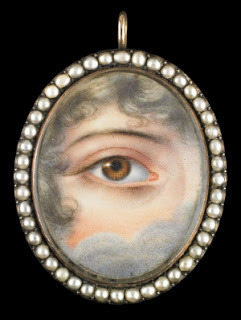 Oval Gold Pendant surrounded by seed pearls.ca 1830
Oval Gold Pendant surrounded by seed pearls.ca 1830The Look of Love: Eye Miniatures from the Skier Collection The exhibition opens May 15, 2014, and runs through August 24, at the Minneapolis Institute of Arts Click here for their website.
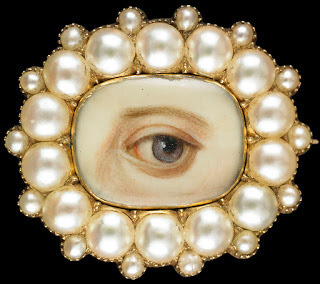 Gold Oval brooch and pendant surrounded by split pearls, ca. 1835-40 Here at Number One London, we have a close and affectionate feeling for this wonderful and unique exhibition. Our frequent guest blogger Jo Manning wrote some very special stories for the catalogue.
Gold Oval brooch and pendant surrounded by split pearls, ca. 1835-40 Here at Number One London, we have a close and affectionate feeling for this wonderful and unique exhibition. Our frequent guest blogger Jo Manning wrote some very special stories for the catalogue.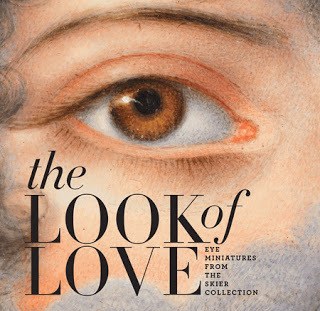
Here is Jo's blog about the original opening at the Birmingham Museum of Art in March, 2012.
 Bracelet surmounted with miniature in gold surround with drop pearl; plaited hairwork on reverse; gray right eye. n.d.
Bracelet surmounted with miniature in gold surround with drop pearl; plaited hairwork on reverse; gray right eye. n.d.Victoria had a delightful meeting with Nan Skier at the original venue, the Birmingham Museum of Art in Alabama visited in April, 2012. You can read an account of that meeting here.
Jo attended the opening at the Look of Love Exhibitions' second venue in Georgia, and wrote about it here.
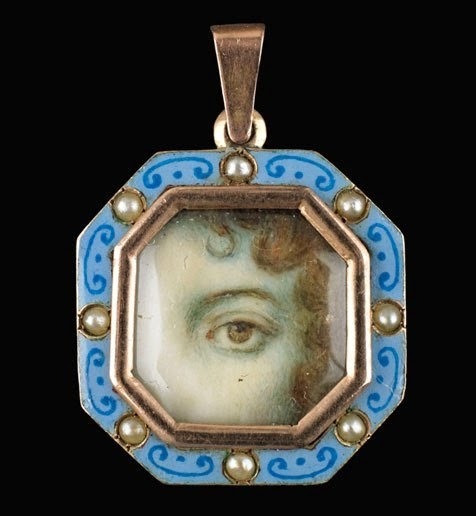 Rose gold octagonal pendant surrounded by blue enamel with half pearls. Brown left eye.
Rose gold octagonal pendant surrounded by blue enamel with half pearls. Brown left eye.The Look of Love exhibition was also shown at the Winterthur Museum in Delaware. September 21, 2013 - January 5, 2044. Click here for more information.
 Gold oval brooch surrounded by foil-backed red pastes, ca. 1790. Blue left eyesurrounded by curls. Attributed to Richard Cosway.
Gold oval brooch surrounded by foil-backed red pastes, ca. 1790. Blue left eyesurrounded by curls. Attributed to Richard Cosway.Here's hoping you have had an opportunity to see this outstanding collections of treasures!
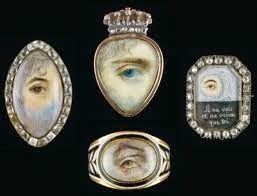
All photos, ©Birmingham Museum of Art, Sean Pathasema, photographer
Published on May 14, 2014 00:30
May 12, 2014
WHAT'S IN A NAME? THE BIRTH OF "WELLINGTON"
By Guest Blogger Greg Roberts
 William Wellesley-Pole (1763-1845)
William Wellesley-Pole (1763-1845)Historians have always been particularly nasty about Arthur Wellesley’s older brother William Wellesley-Pole. He has been variously described as ‘opportunistic and not a little devious’; ‘the worst type of hanger-on’; and harshest of all: ‘a nonentity’. To cap it all his obituary in The Times is still considered one of the most savage ever printed:
[He] was simply angry- angry at all times with every person and about everything.; his sharp, shrill, loud voice grating on the ear…an undignified ineffective speaker, an indiscreet politician…advancing in years without improving in reputation.
Over the years I have presented papers at various venues including the Wellington Congress intended to overturn this somewhat biased and inaccurate assessment of Wellesley-Pole. In any other family he would have been feted, but Wellesley-Pole was dwarfed by the achievements of his other brothers; Richard, Governor General of India (1797-1805); and Arthur, perhaps Britain’s greatest military general. But we should remember that Wellesley-Pole was responsible for the silver coinage introduced in 1817 which remained in circulation until 1971 - and this was just one of several enduring achievements in his own right. Far from being a ‘nonentity’ Wellesley-Pole was actually a very loyal and trustworthy brother, content to stay out of the limelight, and blessed with the one gift that eluded all the Wellesley clan: a long and happy marriage. The one thing that historians cannot ignore is the role that Wellesley-Pole played in the creation of ‘Wellington’. This is revealed in the Raglan MS at Gwent Archives, containing correspondence between Wellesley-Pole and Arthur covering a decade from 1807. This very important primary source is often used to illustrate Arthur’s unvarnished opinions about the performance of government, progress of the war, and the conduct of his family during these momentous years. Yet the many letters FROM Wellesley-Pole TO Arthur are scarcely ever acknowledged even though these contain an equally rich vein of personal insight. It is almost as if Wellesley-Pole is considered persona non-gratis - even in his own archives.But by reading both sides of the Raglan MS it becomes clear that, from his position at the heart of government, Wellesley-Pole acted as Arthur’s ‘remote-secretary’. His services ranged from provision of tea and other home comforts, through to supplying a new sword or replacement horses. He relayed the latest news, gathered opinions, and soothed often fractious relations between the Cabinet and the Peninsular Army. Hence, following Arthur’s victory at Talavera in 1809 Wellesley-Pole was asked to find a suitable title for his feted brother. He was reluctant to be saddled with such an important responsibility, but King would not wait, and an immediate decision was required. So Wellesley-Pole took up his pen and wrote to Arthur:
After ransacking the peerage… I at last determined upon Viscount Wellington of Talavera and of Wellington, and Baron Douro of Welleslie in the County of Somerset. Wellington is a town not far from Welleslie, and no person has chosen the title. I trust that you will not think there is anything unpleasant or trifling in the name of Wellington, but [in the] circumstances… I could not easily have done better. I own I feel in rather an embarrassing situation for it is impossible for me to know whether I have acted as you would have had me…but you should have explained to me your wishes before ever you left England, in case of such an event.
In the anxious days awaiting a reply from the Peninsular, Wellesley-Pole’s nerves would hardly have been soothed when Arthur’s wife Kitty declared ‘Wellington I do not like for it recalls nothing. However, it is done & I suppose it could not be avoided.’ The fact Wellesley-Pole did not consult Kitty says a lot about the role of women in society at that time, for it seems odd that she was presented with a fait accompli, and literally had to live with Wellesley-Pole’s decision for the rest of her life. Eventually and to Wellesley-Pole’s immense relief his choice of title met with unqualified approval from Arthur:
My opinion is that you have done exactly what you ought to have done… You have chosen most fortunately, and I am very much obliged to you. I could not have been better off for a name if we had discussed the subject twenty times
It’s a shame to see how lazily generations of historians have negatively pigeon-holed Wellesley-Pole, when denying his close relationship with Wellington must surely prevent a fuller understanding of this great military genius. Even the creation of ‘Wellington’ is too often considered an egotistical act on Wellesley-Pole’s when a quick perusal of the relevant letters can easily demonstrate that Wellesley-Pole had no choice but to stand proxy, and that his motives were honourable as he tried to balance the needs of government with the wishes of his beloved brother.If you would like to know more about the Wellesley-Pole family, please check out my blog www.wickedwilliam.com at which I will be doing a series of posts devoted to Wellington’s relationship with Wellesley-Pole’s children: Mary Bagot, ‘Wicked William’ Long-Wellesley, Priscilla Burghersh & Emily Raglan. This quartet each played very significant but wildly differing roles in the life and times of the Duke of Wellington.
You can follow Greg Roberts on Twitter: @geggly @Mary_Bagot
Published on May 12, 2014 00:00
May 9, 2014
THE DUKE OF WELLINGTON TOUR - VIDEO HIGHLIGHTS - PART 9
HIGHCLERE CASTLE
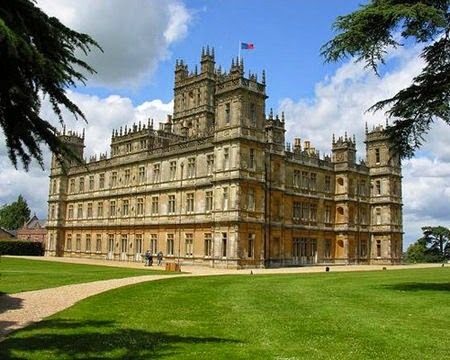
One of the stops along the route of The Duke of Wellington Tour that we're looking forward to visiting is Highclere Castle, home of the Earls of Carnarvon. In addition to the fabulous interiors, we'll also be viewing the Egyptian collection, comprised of artifacts from King Tut's tomb, the discovery of which was funded by the 5th Earl of Carnarvon. I'm particularly interested in walking the grounds and seeing the park, designed by Capability Brown. Here are a few video highlights of what we'll be seeing at Highclere -
The 8th Countess of Carnarvon discusses The Real Downton Abbey and offers a tour of the Castle here.
Follow the Countess through more rooms in the Castle here.
Footage of the exteriors, grounds and secret garden here.
If you were invited to spend the weekend at Downton Abbey's Highclere Castle a hundred years ago,would you know what to wear, how to act, which fork to use? Michael Bertolini, Curator and President of the Warwick (NY) Historical Society gives an informative Talk on Downton Abbey-style living. (1 hour)
For absolutely stunning scenery of the countryside surrounding Highclere Castle, you can watch this five minute video - The Wayfarers Walking Vacations "Downton Abbey" walk .
Victoria will be writing next weeks "Video Highlights" post, in which she'll bring you clips of the flip side of Highclere Castle - Downton Abbey. Until then, here's a very funny bit of silliness put together for Red Nose Day 2011 called "Uptown Downstairs Abbey."
COMPLETE DETAILS OF THE DUKE OF WELLINGTON TOUR CAN BE FOUND HERE.
Published on May 09, 2014 00:00
May 7, 2014
LONDON'S RICHEST TUBE LINES
Piccadilly and Northern Line Commuters The Wealthiest in London
• Piccadilly Line commuters earn more than £56k on average• Commuters on Hammersmith & City Line are least well-off• Commuters on Deep Level lines earn 20 per cent more
Commuters on the Piccadilly and Northern Line are the richest in London, according to the London offices of Randstad the specialist recruiter.
A survey of 1,000 working Londoners who spend the majority of their commute on the Tube found the average salary of someone commuting on the Piccadilly Line is £56,250. The Northern Line trails close behind at £47,250.
Mark Bull, CEO of Randstad said: “With Bank a key stop on the Northern Line, you might think this would be the wealthiest tube line. While twenty years ago the Square Mile was home to pretty much every financial institution in London, the wealth has now spread east to Canary Wharf and west to the West End. The Piccadilly line, though, runs right through Green Park and Piccadilly Circus – which has become prime private equity territory over the last thirty years. As the gentlemen’s clubs of St James have moved out, the venture capitalists have moved in.
“Perhaps it’s fitting that Piccadilly line is home to the capital’s richest commuters now. During the war, the British Museum stored some of its most treasured antiquities – including the Elgin Marbles – into a disused spur of the Piccadilly line . The capital’s wealth is clearly very at home there.”
“It’s not all bad on the Northern Line though. Bank might have been voted the "Most Disliked" tube station in London – and Kennington might be haunted – but in terms of hard cash, the Northern Line is anything but The Misery Line”
Despite connecting Moorgate and Liverpool Street with the rest of London, the average salary of commuters on the Hammersmith & City Line is just £35,250.

The Hammersmith & City line is not the only sub-surface line that moves less wealthy commuters. Commuters on the District, Circle, Metropolitan and Hammersmith & City lines are paid, on average, 20 per cent less than those on the deep-level lines.

Mark Bull said, “Sub-surface commuters may luxuriate in spacious air-conditioned coaches, but when it comes to comparing pay-packets between the deep level lines and their subsurface equivalents, it’s a case of mind the gap. While the deep level lines are known for their punishing journeys, overcrowding, and cramped conditions, the extra cash commuters are pocketing should help ease the pain.”
While very few of London’s tube commuters spend the majority of their commute on the Waterloo & City line, those that do are technically speaking the wealthiest of all – average salaries on the Waterloo & City line are £81,250.
Career Choices Reflected in Tube Lines Most TravelledThe Northern line is the most used line by a variety of professions, from Customer Services and Leisure and Hospitality workers to corporate commuters in IT and Professional Services, some professions are more prevalent on certain tube lines than others.

Mark Bull said: “Tube commuters are notorious for trying to create the illusion of their own private space, despite packed cars and it’s rare passengers glance up from their smart phones, iPods or newspapers with very few words spoken on a typical journey – if at all. On certain lines, if tube travellers did strike up a conversation they might just find that they have more in common with the person standing next to them than they might think. In fact, in many cases they could be heading to the same employer – which in some cases may explain the radio silence!”
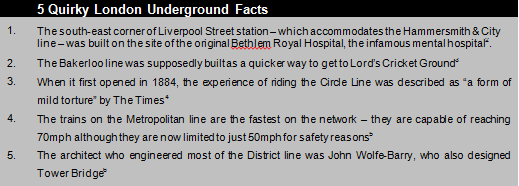
[1] British Museum
[2] Mysterious Britain
[3] Randomly London
[4] Insider London
[5] London Wikia
[6] Graces Guide
Published on May 07, 2014 00:00
May 5, 2014
AT THE CORCORAN - PART THREE: Salon Doré
Victoria here. The Corcoran lions guard the doors of the gallery, in Washington, D. C., behind which are many treasures, including the Salon Doré, or Gilded Room, an excellent example of French 18th century décor.

I visited with author Diane Gaston, a long-time friend and fellow traveler to England and elsewhere in search of Georgian/Regency-era delights. Diane was as gob-smacked by the beauty of the Salon Doré as I was and we both snapped picture after picture. She was much faster at blogging about our visit than I was. Click here for her post.
 Salon Doré at the Corcoran Gallery of Art
Salon Doré at the Corcoran Gallery of Art
This installation is the third for the sumptuous ceilings and paneling. The room was created in 1770 as a wedding gift to his bride by Pierre Gaspard Marie Grimod d'Orsay (1748-1809). The artist was Jean-François-Thérèse Chalgrin (1734-1811). Some early descriptions of the room say it was fashioned for the wedding ceremony itself. In the early 20th century, D'Orsay's mansion, the building now known as Hôtel de Clarmont (68 rue de Varenne, Faubourg Saint-Germain, Paris), was stripped of the Chalgrin work and it was acquired by American mining millionaire and industrialist (aka robber baron) and Montana Senator William A. Clark (1839-1925). Clark installed the room in his Fifth Avenue, NYC, mansion about 1904. He was a benefactor of the Corcoran in its early years, and the fittings of the Salon Doré were moved to the gallery in 1926.

Count d'Orsay and his wife, the former Marie-Louise-Albertine-Amélie, Princess de Croÿ-Molenbais, had one son who in turn fathered Alfred Guillaume Gabriel, Count d'Orsay (1801-1852) , a famous dandy who was well known in England in the 19th century, friend of the famous and infamous, such as Lord Byron, Benjamin Disraeli, and Edward Bulwer-Lytton. Read about the Duke of Welllington and Count Dorsay here.
 Decorative Panels
Decorative Panels
The Corcoran's Salon Doré is one of the finest examples of French Rococo style from the reign of Louis Quinze (XV). Another such gilded salon from Paris can be found in San Francisco's Legion of Honor Museum. Read more about it here.
 Detail of paneling: Corcoran's Salon Doré
Detail of paneling: Corcoran's Salon Doré
 Gilded corner tables (encoignures) by Jean-François-Thérèse Chalgrin (French, 1734-1811)
Gilded corner tables (encoignures) by Jean-François-Thérèse Chalgrin (French, 1734-1811)
: The four corner tables, along with most of the other furniture from the original room, were confiscated and dispersed during the French Revolution. Though the other pieces are still lost the Corcoran acquired the four corner tables just a few years ago, in 2008, and placed them in their original positions in the Salon Doré.
 Ceiling Details are not the originals but were created for the museum installation
Ceiling Details are not the originals but were created for the museum installation
 Clock of the Vestals
Clock of the Vestals
The Case was made by Pierre-Philippe Thomire (French 1751-1843) bout 1789. The clock was created by Robert Robin, (French 1742-99), signed on the dial Robin/Hger Du Roi (clockmaker to the King). The media are gilded, patinated, and painted bronze, Sevrès porcelain, enamel on copper, and marble. From the Corcoran's website: The Clock of the Vestals marked the passing of the hours in Queen Marie-Antoinette’s boudoir, or private sitting room, in the Tuileries Palace in Paris, adjacent to the Palais du Louvre. The royal family was forced to move there in October 1789 after a mob of Parisians attacked the palace at Versailles, the official residence of the king for over 100 years. In the Tuileries the king and queen held court in gilded splendor but were state prisoners nonetheless. Their last unhappy days together were passed in this palace before they were permanently separated in the mean quarters where they awaited their executions in 1793...The scene on the clock may depict the moment when the vestals, warned of the approach of the Gauls (c. 389), took the sacred fire and vessels from the temple and fled from Rome to Caere, a nearby city...At least sixteen versions of the Clock of the Vestals are known, each having some variation in materials and secondary elements. The clock in the Musée des Arts Décoratifs in Paris, dated 1788, is closest in appearance to the Corcoran clock."
 Paneled Doors of the Salon Doré
Paneled Doors of the Salon Doré
From the Corcoran Gallery's website: "The Salon Doré as we know it today is the product of these two great patrons of the arts, the French Count d’Orsay and the Francophile Senator Clark. Even though one was an 18th-century Frenchman born to wealthand privilege and the other was a 19th-century self-made American industrialist, they are linked across the ages as passionate collectors of the antique and the Old World who at the same time used art and architecture to foster their social ambitions."
 The Corcoran's Staircase
The Corcoran's Staircase
Other Salon Dorés can be found in palaces, mansions, and museums. Another I have enjoyed visiting was recently re-furbished at the Palace of the Legion of Honor, part of San Francisco's Fine Arts Museums. Learn about it here.
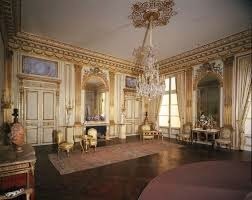 Salon Doré. from the Hôtel de La Trémoille, ParisFine Arts Museums of San Francisco
Salon Doré. from the Hôtel de La Trémoille, ParisFine Arts Museums of San Francisco

I visited with author Diane Gaston, a long-time friend and fellow traveler to England and elsewhere in search of Georgian/Regency-era delights. Diane was as gob-smacked by the beauty of the Salon Doré as I was and we both snapped picture after picture. She was much faster at blogging about our visit than I was. Click here for her post.
 Salon Doré at the Corcoran Gallery of Art
Salon Doré at the Corcoran Gallery of ArtThis installation is the third for the sumptuous ceilings and paneling. The room was created in 1770 as a wedding gift to his bride by Pierre Gaspard Marie Grimod d'Orsay (1748-1809). The artist was Jean-François-Thérèse Chalgrin (1734-1811). Some early descriptions of the room say it was fashioned for the wedding ceremony itself. In the early 20th century, D'Orsay's mansion, the building now known as Hôtel de Clarmont (68 rue de Varenne, Faubourg Saint-Germain, Paris), was stripped of the Chalgrin work and it was acquired by American mining millionaire and industrialist (aka robber baron) and Montana Senator William A. Clark (1839-1925). Clark installed the room in his Fifth Avenue, NYC, mansion about 1904. He was a benefactor of the Corcoran in its early years, and the fittings of the Salon Doré were moved to the gallery in 1926.

Count d'Orsay and his wife, the former Marie-Louise-Albertine-Amélie, Princess de Croÿ-Molenbais, had one son who in turn fathered Alfred Guillaume Gabriel, Count d'Orsay (1801-1852) , a famous dandy who was well known in England in the 19th century, friend of the famous and infamous, such as Lord Byron, Benjamin Disraeli, and Edward Bulwer-Lytton. Read about the Duke of Welllington and Count Dorsay here.
 Decorative Panels
Decorative PanelsThe Corcoran's Salon Doré is one of the finest examples of French Rococo style from the reign of Louis Quinze (XV). Another such gilded salon from Paris can be found in San Francisco's Legion of Honor Museum. Read more about it here.
 Detail of paneling: Corcoran's Salon Doré
Detail of paneling: Corcoran's Salon Doré Gilded corner tables (encoignures) by Jean-François-Thérèse Chalgrin (French, 1734-1811)
Gilded corner tables (encoignures) by Jean-François-Thérèse Chalgrin (French, 1734-1811): The four corner tables, along with most of the other furniture from the original room, were confiscated and dispersed during the French Revolution. Though the other pieces are still lost the Corcoran acquired the four corner tables just a few years ago, in 2008, and placed them in their original positions in the Salon Doré.
 Ceiling Details are not the originals but were created for the museum installation
Ceiling Details are not the originals but were created for the museum installation Clock of the Vestals
Clock of the VestalsThe Case was made by Pierre-Philippe Thomire (French 1751-1843) bout 1789. The clock was created by Robert Robin, (French 1742-99), signed on the dial Robin/Hger Du Roi (clockmaker to the King). The media are gilded, patinated, and painted bronze, Sevrès porcelain, enamel on copper, and marble. From the Corcoran's website: The Clock of the Vestals marked the passing of the hours in Queen Marie-Antoinette’s boudoir, or private sitting room, in the Tuileries Palace in Paris, adjacent to the Palais du Louvre. The royal family was forced to move there in October 1789 after a mob of Parisians attacked the palace at Versailles, the official residence of the king for over 100 years. In the Tuileries the king and queen held court in gilded splendor but were state prisoners nonetheless. Their last unhappy days together were passed in this palace before they were permanently separated in the mean quarters where they awaited their executions in 1793...The scene on the clock may depict the moment when the vestals, warned of the approach of the Gauls (c. 389), took the sacred fire and vessels from the temple and fled from Rome to Caere, a nearby city...At least sixteen versions of the Clock of the Vestals are known, each having some variation in materials and secondary elements. The clock in the Musée des Arts Décoratifs in Paris, dated 1788, is closest in appearance to the Corcoran clock."
 Paneled Doors of the Salon Doré
Paneled Doors of the Salon Doré From the Corcoran Gallery's website: "The Salon Doré as we know it today is the product of these two great patrons of the arts, the French Count d’Orsay and the Francophile Senator Clark. Even though one was an 18th-century Frenchman born to wealthand privilege and the other was a 19th-century self-made American industrialist, they are linked across the ages as passionate collectors of the antique and the Old World who at the same time used art and architecture to foster their social ambitions."
 The Corcoran's Staircase
The Corcoran's StaircaseOther Salon Dorés can be found in palaces, mansions, and museums. Another I have enjoyed visiting was recently re-furbished at the Palace of the Legion of Honor, part of San Francisco's Fine Arts Museums. Learn about it here.
 Salon Doré. from the Hôtel de La Trémoille, ParisFine Arts Museums of San Francisco
Salon Doré. from the Hôtel de La Trémoille, ParisFine Arts Museums of San Francisco
Published on May 05, 2014 00:30
May 2, 2014
THE DUKE OF WELLINGTON TOUR -- VIDEO HIGHLIGHTS - PART 8
Stratfield Saye

To understand why the Duke of Wellington's country house is the relatively modest Stratfield Saye, it is necessary to travel back to the victory of the Duke of Marlborough at the Battle of Blenheim in August 1704 over the forces of French King Louis XIV (and others).. England's Queen Anne and her ministers were so delighted with the Duke's victory that they decided to build him a great palace, a rival to their defeated enemy's Palace of Versailles.
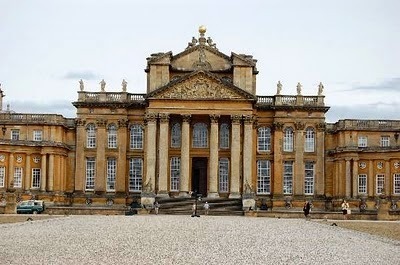 Blenheim Palace, Oxfordshire
Blenheim Palace, Oxfordshire
If you visit Blenheim, you will see what the first Duke of Wellington learned from the magnificent but very costly house. For two centuries, the Marlborough family had struggled to complete and maintain the enormous palace. So when offered a great Waterloo Palace as a gift from the nation after his victory over Napoleon, Wellington proceeded cautiously. The Iron Duke knew what a burden Blenheim had been to its owners.
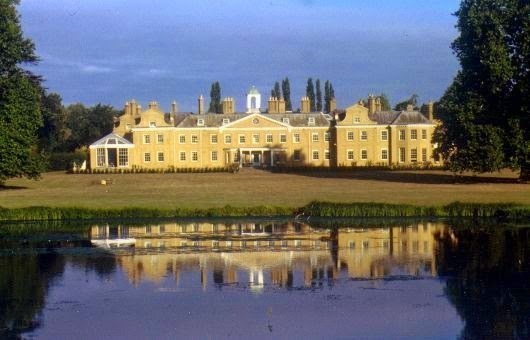 Stratfield Saye
Stratfield Saye
Always the clever strategist, the first Duke of Wellington chose a house he and his descendants could afford, perhaps sacrificing magnificence for comfort. This pleasant 90-second video shows several views of the house.
 The Hall, showing captured battle flags
The Hall, showing captured battle flags
The present ducal family lives at Stratfield Saye and access to the house is very limited. We could find no videos of the interior, so to see the rooms in which the Dukes and Duchesses lived, you will have to sign up and come along on The Duke of Wellington Tour.
For more exterior views plus the Duke's Funeral Car, on display in the stables, here is another video. Sadly, the cameraman kept moving -- so don't get seasick while you watch it!
Did you know that the cavalry charge scene from the Spielberg film War Horse was filmed at Stratfield Saye? Actor Tom Hiddleston explains how the Duke's estate came to substitute for a French Battlefield in this video.

You can watch the cavalry charge film sequence here. How ironic that a scene of British military defeat should be filmed on the grounds of the home of Britain's greatest military hero.
The Stratfield Saye Website is here.
COMPLETE DETAILS AND ITINERARY FORTHE DUKE OF WELLINGTON TOUR CAN BE FOUND HERE

To understand why the Duke of Wellington's country house is the relatively modest Stratfield Saye, it is necessary to travel back to the victory of the Duke of Marlborough at the Battle of Blenheim in August 1704 over the forces of French King Louis XIV (and others).. England's Queen Anne and her ministers were so delighted with the Duke's victory that they decided to build him a great palace, a rival to their defeated enemy's Palace of Versailles.
 Blenheim Palace, Oxfordshire
Blenheim Palace, OxfordshireIf you visit Blenheim, you will see what the first Duke of Wellington learned from the magnificent but very costly house. For two centuries, the Marlborough family had struggled to complete and maintain the enormous palace. So when offered a great Waterloo Palace as a gift from the nation after his victory over Napoleon, Wellington proceeded cautiously. The Iron Duke knew what a burden Blenheim had been to its owners.
 Stratfield Saye
Stratfield SayeAlways the clever strategist, the first Duke of Wellington chose a house he and his descendants could afford, perhaps sacrificing magnificence for comfort. This pleasant 90-second video shows several views of the house.
 The Hall, showing captured battle flags
The Hall, showing captured battle flagsThe present ducal family lives at Stratfield Saye and access to the house is very limited. We could find no videos of the interior, so to see the rooms in which the Dukes and Duchesses lived, you will have to sign up and come along on The Duke of Wellington Tour.
For more exterior views plus the Duke's Funeral Car, on display in the stables, here is another video. Sadly, the cameraman kept moving -- so don't get seasick while you watch it!
Did you know that the cavalry charge scene from the Spielberg film War Horse was filmed at Stratfield Saye? Actor Tom Hiddleston explains how the Duke's estate came to substitute for a French Battlefield in this video.

You can watch the cavalry charge film sequence here. How ironic that a scene of British military defeat should be filmed on the grounds of the home of Britain's greatest military hero.
The Stratfield Saye Website is here.
COMPLETE DETAILS AND ITINERARY FORTHE DUKE OF WELLINGTON TOUR CAN BE FOUND HERE
Published on May 02, 2014 00:30
Kristine Hughes's Blog
- Kristine Hughes's profile
- 6 followers
Kristine Hughes isn't a Goodreads Author
(yet),
but they
do have a blog,
so here are some recent posts imported from
their feed.



